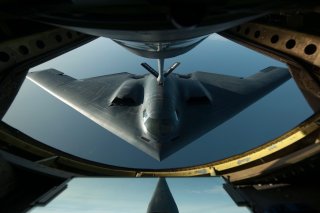Where Is Biden’s Nuclear Strategy Headed?
Recent disclosures and the FY2023 budget submission give us a relatively clear idea of where U.S. nuclear deterrent policy and strategy are headed.
The Biden administration has sent Congress the United States’ sixth Nuclear Posture Review since the end of the “first” Cold War in 1991. While still classified, recent disclosures and the FY2023 budget submission give us a relatively clear idea of where U.S. nuclear deterrent policy and strategy are headed.
Most important to the administration is the requirement to get the United States back into the lead with respect to nuclear arms control deals (which may or may not be compatible with deterrent requirements).
There appear to be at least four aspects of this policy: First, bring back the 1987 Intermediate-Range Nuclear Forces (INF) Treaty; second, secure a new Iran nuclear agreement known originally as the Joint Comprehensive Program of Action (JCPOA); third, extend and expand the New START Treaty of 2010; and fourth, unilaterally cut U.S. nuclear forces to 1,000 or fewer warheads.
The Russians have serially violated the INF treaty, and as such, it became untenable to continue adhering to a treaty with only one participant—Washington. Yet this fact is not readily apparent from the news coverage of the INF following the U.S. withdrawal.
The nuclear agreement with Iran follows the same pattern. A number of analyses by the Institute for Science and International Security explain that Iran never fully adhered to the terms of the original 2015 JCPOA, especially in that Iran did not disclose its previous nuclear weapons technology activities to the International Atomic Energy Agency (IAEA). The IAEA has effectively ignored this point, despite that the IAEA is required to verify any previous Iranian nuclear work under the JCPOA.
It was only an Israeli raid on a warehouse filled with Iranian nuclear documents and their subsequent disclosure that revealed a significant Iranian effort to gather nuclear weapons technology. In the words of General Michael Hayden, a former U.S. national intelligence chief, Iran has become an “industrial strength nuclear state”—and the JCPOA did not prevent this, but rather facilitated it.
So, while the United States did withdraw from the JCPOA, it did so not as a result of any animus toward arms control deals in principle, but particularly because this nuclear deal did little to prevent Iran from securing a nuclear-weapons capability,
As for the New START Treaty, the Trump administration adhered to the agreement, and it has now been extended for an additional five years by the Biden administration. It is unclear, therefore, what aspect of the New START Treaty needs to be enhanced. The United States has been and remains in strict adherence to its terms, although between three to five Russian strategic nuclear systems under development and in production may not be limited under the treaty, much as some 55 percent of Russia’s deployed strategic and regional nuclear forces are not limited by New START.
Thus, while Washington seeks to “lead” the world into an arms control future, it is unclear how it intends to do so. How can the United States resurrect the INF Treaty without Russian compliance? How would Congress approve a new or amended JCPOA (as required by law) that also removes a number of Iranian entities from the U.S. foreign terrorist list despite them posing the primary threats to America’s Middle East partners?
If the United States is looking to secure a new nuclear arms deal with Russia—or even China—some questions and (Congressional) concerns must be answered beforehand. Indeed, any new strategic arms control deal would need to account for: all of Russia’s nuclear weapons, including the multiple thousands of tactical, theater nuclear systems; and China’s ongoing, “breathtaking” nuclear weapons buildup, variously projected to reach between 1,000-2,500 warheads by 2030-2040. It is in this light that any unilateral U.S. arms control measures, irrespective of what Russia and China are undertaking, should be evaluated.
For example, in its proposed FY23 budget, the administration eliminates the Navy’s proposed short-range, nuclear-armed cruise missile and the megaton-class B-83 gravity bomb carried by the B-2.
Looking down the road, the disarmament community continues to push for unilateral cuts by ending the new Sentinel land-based intercontinental ballistic missile (ICBM) force and reducing U.S. strategic deterrent forces to 1,000 or fewer nuclear weapons, a 55 percent reduction.
However, while the United States is seeking to “do arms control,” the United States is also simultaneously putting forward an FY23 budget that, apart from the cuts mentioned above, actually keeps in place most of the nuclear deterrent modernization of the previous two administrations—which Congress has fully supported since 2010. In fact, Congress has modestly added funds to past nuclear deterrent force budgets.
Consequently, by adopting some of the disarmament communities’ ideas and simultaneously proceeding with nuclear modernization, the administration may be giving contradictory signals to the United States’ allies and enemies. The Russians and Chinese could accept the proposed unilateral concessions and provide the United States with nothing in return. But U.S. allies, especially in NATO and in the Western Pacific, could find these unilateral measures concerning if they were undertaken without care for how they affect U.S. extended nuclear deterrence. The administration’s consideration of adopting a “no first use” (NFU) nuclear doctrine, for example, disturbed America’s allies and, in response, the administration wisely rejected such a posture.
With its emphasis on reinvigorating “arms control,” the administration could wisely move to corral both non-compliant Russian theater systems and the entirely of the growing Chinese arsenal, which, if successful, could significantly improve U.S. security. However, considering that the Chinese have rejected such negotiations unless the United States and Russia first cut their nuclear stockpiles to current Chinese levels, it appears that China’s security leadership has no interest in nuclear arms control.
Peter Huessy is President of Geostrategic Analysis. These views are his own.
Image: Flickr.

